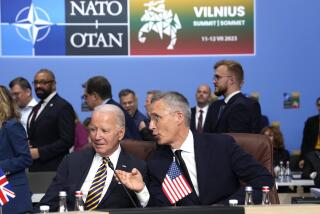The Washington Summit : Shultz Leaves for Brussels to Brief NATO Allies
- Share via
WASHINGTON — Minutes after Soviet leader Mikhail S. Gorbachev left for home Thursday, Secretary of State George P. Shultz departed from the same U.S. air base for Brussels to urge the North Atlantic Treaty Organization to follow up the new intermediate nuclear forces treaty with an energetic program to overcome Soviet advantages in conventional forces in Europe.
Shultz planned to review the results of President Reagan’s summit talks with Gorbachev at a NATO foreign ministers meeting today and Saturday before embarking on a diplomatic tour of Denmark, Norway, West Germany and Britain.
The foreign ministers, NATO’s chief policy-making group, are certain to endorse the treaty signed by Reagan and Gorbachev to ban ground-launched nuclear missiles with ranges of between 300 and 3,000 miles. U.S. officials have kept the allies fully informed during the course of the negotiations, and the foreign ministers have already endorsed the pact’s major provisions.
However, by eliminating the intermediate- and shorter-range missiles that formed an important part of NATO’s nuclear deterrent, the treaty underlines the superiority of the Soviet-led Warsaw Pact in numbers of tanks, troops and other measures of conventional military force in Europe.
Conventional Cutbacks
“We should bring about a better balance of conventional arms than now exists,” Shultz said in a televised interview Thursday. “That means strengthening our NATO forces and being ready to talk with the Soviets and their allies about conventional force reductions.”
He said he hopes that a new round of negotiations over conventional arms in Europe could begin early next year. NATO has already endorsed the negotiations to replace the mutual and balanced force reduction talks that have dragged on without results in Vienna since 1973.
Interviewed on ABC-TV’s “Good Morning America,” Shultz said that a conventional agreement would have to require much deeper cuts by the Warsaw Pact than by NATO because the Soviet-led alliance starts with a large numerical advantage.
Asymmetrical Reductions
Gorbachev agreed during his summit talks with Reagan that the conventional cuts would have to be asymmetrical. But the Soviets have not yet indicated that they are prepared for the magnitude of reductions that the West believes is necessary to redress the balance.
Washington and Moscow cannot settle the conventional issue by themselves because their allies play a much more important role in non-nuclear defenses.
“Now that’s a very different matter than the strategic arms talks or the intermediate-range talks because . . . we’re talking about troops and armaments of our European allies,” Shultz said.
Although all NATO governments officially support the intermediate nuclear forces treaty, some European officials have expressed concern that the deal will leave Europe less safe in the face of Soviet tanks and artillery.
Treaty Called Mistake
Gen. Bernard W. Rogers, a U.S. Army officer who retired this year after almost a decade as NATO’s military commander, maintains that the treaty is a serious mistake.
“This treaty puts Western Europe on the slippery slope to denuclearization,” Rogers said in a speech this week. “The Soviets want to make Western Europe safe again for conventional war and, with massive conventional forces as the backdrop, to be able to intimidate, coerce, blackmail and neutralize Western Europe without firing a single shot.”
More to Read
Sign up for Essential California
The most important California stories and recommendations in your inbox every morning.
You may occasionally receive promotional content from the Los Angeles Times.










